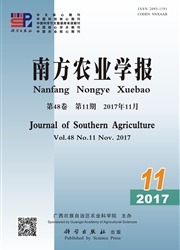

 中文摘要:
中文摘要:
【目的】探讨珠江三角洲农田植被的碳储量、碳密度及其动态,为区域的碳循环研究和农田生态健康评估提供依据。【方法】根据珠三角农作物产量及其经济系数、平均含碳量与果实含水率等数据,运用碳储量模型估算1993-2010年珠江三角洲农作物的碳储量和碳密度动态变化。【结果】珠江三角洲农田生态系统植被碳储量和碳密度从1993年的5.71×10^6和5.70t/ha,下降到2010年的2.83×10^6t和4.00t/ha。在珠三角洲各市中,佛山和中山的碳储量下降趋势最显著,而广州和佛山的碳密度下降趋势最明显。2010年,肇庆的碳密度(3.09t/ha)最高,珠海(2.86t/ha)次之,深圳(0.49t/ha)最低,其余7个城市的碳密度为0.80~3.00t/ha。水稻、甘蔗和蔬菜是珠三角农田植被碳储量构成中占比例最大的农作物,甘蔗(13.92t/ha)的平均碳密度最高,水稻(3.76t/ha)次之,蔬菜(0.63t/ha)最低。近年来珠三角农田植被中蔬菜所占比例增大,故与邻近区域相比其碳密度较低。【结论】珠江三角洲农田生态系统植被碳储量和碳密度总体呈下降趋势,耕地面积下降和种植结构变化是导致珠三角农田植被碳储量下降的主要原因,珠三角农田植被碳密度的下降则与种植结构变化有关。
 英文摘要:
英文摘要:
[Objective]The study aimed to calculate the carbon storage and carbon density of farmland vegetation in Pearl River Delta as well as explore their dynamic. This study would provide basic data for further researches on regional carbon cycle and assessments of farmland ecological health. [ Method ] Based on the data of yield, economic coefficients, moisture content rates and carbon content rates of crop in Pearl River Delta, the dynamic variation of vegetation carbon storage and carbon density of farmland ecosystem in Pearl River Delta in 1993-2010 was calculated using carbon storage model. [Result]The results showed that the vegetation carbon storage and carbon density of farmland ecosystem in Pearl River Delta changed from 5.71×10^6 t and 3.02 t/ha in 1993 to 2.83×10^6 t and 2.39 t/ha in 2010,respectively. In the 9 cities of Pearl River Delta,the decline of carbon storage in Foshan and Zhongshan was the most significant,while the carbon density of Guangzhou and Foshan decreased markedly. In 2010,the crop carbon density,Zhaoqing (3.09 t/ha) was the highest and Zhuhai (2.86 t/ha) was the second while as for (0.49 t/ha) Shenzhen, was the lowest. Other cities were in 0.80-3.0 t/ha. Rice,sugarcane and vegetables had a larger proportion of the vegetation carbon storage of farmland ecosystem in Pearl River Delta. There were the highest carbon density (13.90 t/ha) in sugarcane,followed by rice (3.59 t/ha). There was relatively low carbon density (0.65 t/ha) in vegetables. Due to the high proportions of vegetables ,the vegetation carbon density of farmland ecosystem in Pearl River Delta was lower than that in neighboring areas. [ Conclusion ] The vegetation carbon storage and carbon density of farmland ecosystem in Pearl River Delta was on the downside. The decrease of arable area and the variation of agricultural product structure was the major reason for the decline of crop carbon storage, and the decline of crop carbon density in Pearl River Delta was basically affected by the variation of agr
 同期刊论文项目
同期刊论文项目
 同项目期刊论文
同项目期刊论文
 DOW CORNING 1-2577 Conformal Coating as an efficient diffusion material for cathode in the microbial
DOW CORNING 1-2577 Conformal Coating as an efficient diffusion material for cathode in the microbial Characterization of Strain Pseudomonas sp Q1 in Microbial Fuel Cell for Treatment of Quinoline-Conta
Characterization of Strain Pseudomonas sp Q1 in Microbial Fuel Cell for Treatment of Quinoline-Conta Distribution of typical denitrifying functional genes and diversity of the nirS-encoding bacterial c
Distribution of typical denitrifying functional genes and diversity of the nirS-encoding bacterial c Estimation of Soil Water Retention Curve from Soil Pore-Solid Structure: an asymmetrical Fractal Mod
Estimation of Soil Water Retention Curve from Soil Pore-Solid Structure: an asymmetrical Fractal Mod Characterization of Cd-, Pb-, Zn-resistant endophytic Lasiodiplodia sp.MXSF31 from metal accumulatin
Characterization of Cd-, Pb-, Zn-resistant endophytic Lasiodiplodia sp.MXSF31 from metal accumulatin Anaerobic Biodegradation of Pyrene by Paracoccus denitrificans Under Various Nitrate/Nitrite-Reducin
Anaerobic Biodegradation of Pyrene by Paracoccus denitrificans Under Various Nitrate/Nitrite-Reducin Investigation into preferential flow in natural unsaturated soils with field multiple-tracer infiltr
Investigation into preferential flow in natural unsaturated soils with field multiple-tracer infiltr Characterization of heavy metal-resistant endophytic yeast Cryptococcus sp. CBSB78 from rapes (Brass
Characterization of heavy metal-resistant endophytic yeast Cryptococcus sp. CBSB78 from rapes (Brass Heavy metal recovery combined with H-2 production from artificial acid mine drainage using the micro
Heavy metal recovery combined with H-2 production from artificial acid mine drainage using the micro Characterizing Heterogeneous Processes of Water Flow and Solute Transport in Soils Using Multiple Tr
Characterizing Heterogeneous Processes of Water Flow and Solute Transport in Soils Using Multiple Tr Effects of biochars derived from different feedstocks and pyrolysis temperatures on soil physical an
Effects of biochars derived from different feedstocks and pyrolysis temperatures on soil physical an Characterization of depth-related bacterial communities and their relationships with the environment
Characterization of depth-related bacterial communities and their relationships with the environment Characterization of Cd- and Pb-resistant fungal endophyte Mucor sp CBRF59 isolated from rapes (Brass
Characterization of Cd- and Pb-resistant fungal endophyte Mucor sp CBRF59 isolated from rapes (Brass Biosorption behavior and mechanism of heavy metals by fruiting body of jelly fungus (Auricularia pol
Biosorption behavior and mechanism of heavy metals by fruiting body of jelly fungus (Auricularia pol Biomass and carbon storage of Eucalyptus and Acacia plantations in the Pearl River Delta, South Chin
Biomass and carbon storage of Eucalyptus and Acacia plantations in the Pearl River Delta, South Chin Development of the Microbial Electrolysis Desalination and Chemical-Production Cell for Desalination
Development of the Microbial Electrolysis Desalination and Chemical-Production Cell for Desalination Improved performance of the microbial electrolysis desalination and chemical-production cell using t
Improved performance of the microbial electrolysis desalination and chemical-production cell using t Ribosomal-sequence-directed selection for endophytic streptomycete strains antagonistic to Ralstonia
Ribosomal-sequence-directed selection for endophytic streptomycete strains antagonistic to Ralstonia Diagenetic alterations of amino acids and organic matter in the upper Pearl River Estuary surface se
Diagenetic alterations of amino acids and organic matter in the upper Pearl River Estuary surface se The source and diagenesis of sediment organic matter in the upper Pearl River Estuary as indicated b
The source and diagenesis of sediment organic matter in the upper Pearl River Estuary as indicated b THE CHARACTERISTICS OF PARTICULATE SIZE AND HEAVY METAL CONCENTRATION IN FOLIAR DUST AND SURFACE DUS
THE CHARACTERISTICS OF PARTICULATE SIZE AND HEAVY METAL CONCENTRATION IN FOLIAR DUST AND SURFACE DUS 期刊信息
期刊信息
